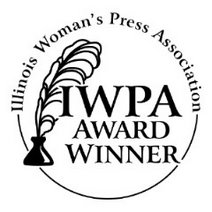I have noticed what seems to be a new trend in printed materials: white or black or colored type on a colored background. Two recent examples: the Life magazine included with yesterday's Chicago Tribune and the back of the Chicago Cultural Center's October schedule.
The Sudoku game in Life was printed in brilliant yellowish-green with white numbers. My vision, as corrected with glasses, is good, but this game seemed impossible to deal with. In order to figure out what the other numbers should be, one needs to read the numbers already there.
The newly-redesigned Cultural Center schedule is generally attractive and informative, but why is the monthly calendar on the back printed mainly in black on a brown background? It's nearly unreadable, as one visitor pointed out yesterday. Many of our Cultural Center visitors are in my age group, and many have much weaker vision than I.
Perhaps this is another example of computer and color printer overkill. I remember that we once went crazy with beautiful but virtually unreadable type fonts on our new computers just because we could. Maybe this is more elderly "What's the world coming to?" but what's wrong with old-fashioned, readable black on white? Explain this new dark background trend to me, design professionals.
Postscript: I have received a few comments on this subject. Margaret Holt, of the Chicago Tribune, asked the Tribune's design director about readability, and he answered that designers are sometimes overly optimistic about printing capability. "What looks good on a 17-inch computer monitor won't necessarily look the same on newsprint." I should add that the Tribune did not produce the unreadable Sudoku puzzle I complained about; the puzzle simply appeared in the Life magazine which was included with the newspaper. I noticed this week that Life has not changed its ways. Oh, well. The puzzles look pretty, and perhaps they're there simply for decorative purposes. It certainly isn't hard to find more readable Sudoku puzzles to actually work on.
I had no official comment from the Chicago Cultural Center, but several people who work there, as well as visitors and other volunteers, agreed with me. The November schedule isn't back to black on white, but it features a calendar on a lighter background than the brown one from October.
Copyright 2006 by Marlys Marshall Styne
Saturday, October 14, 2006
Subscribe to:
Post Comments (Atom)


















1 comment:
I have received a few comments on this subject. Margaret Holt, of the Chicago Tribune, asked the Tribune's design director about readability, and he answered that designers are sometimes overly optimistic about printing capability. "What looks good on a 17-inch computer monitor won't necessarily look the same on newsprint." I should add that the Tribune did not produce the unreadable Sukoku puzzle I mentioned; it simply appeared in Life magazine, which was included with the newspaper.
I had no official comment from the Cultural Center, but several people who work there, as well as several visitors, agreed with me. The November schedule isn't back to black on white, but it featured a calendar on a lighter background than the brown one from october.
Marlys
Post a Comment